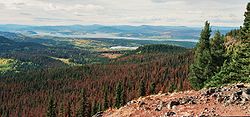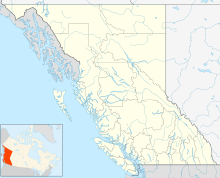Fraser Lake | |
|---|---|
| Village of Fraser Lake[1] | |
 Fraser Lake from Mount Fraser | |
| Motto: "White swan capital of the world!" | |
Location of Fraser Lake in British Columbia | |
| Coordinates: 54°03′30″N 124°50′49″W / 54.05833°N 124.84694°W | |
| Country | Canada |
| Province | British Columbia |
| Region | BC Interior |
| Regional district | Regional District of Bulkley-Nechako |
| Incorporated | 1966 |
| Government | |
| • Governing body | Fraser Lake Village Council |
| • Mayor | Sarrah Storey |
| Area | |
• Total | 4.07 km2 (1.57 sq mi) |
| Elevation | 700 m (2,300 ft) |
| Population (2016) | |
• Total | 988 |
| • Density | 242.9/km2 (629/sq mi) |
| Time zone | UTC-8 (PST) |
| • Summer (DST) | UTC-7 (PDT) |
| Area code | 250 |
| Highways | |
| Waterways | Fraser Lake |
| Website | www |
Fraser Lake is a village in northern British Columbia, Canada. It's located on the southwest side of Fraser Lake[2] between Burns Lake and Vanderhoof alongside the Yellowhead Highway.
The small community's population is primarily employed by either the forest industry. (Fraser Lake Sawmills, or various logging contractors) The Endako Mines, a large molybdenum mine was a former large employer.
The pioneer roots of the area's history date back to the fur trade, with the establishment in 1806 of a fur-trading post by Simon Fraser, at Fort Fraser near the east end of Fraser Lake. The modern day town was established in 1914, during the construction of the Grand Trunk Pacific Railway, and was incorporated as a village in 1966.
- ^ "British Columbia Regional Districts, Municipalities, Corporate Name, Date of Incorporation and Postal Address" (XLS). British Columbia Ministry of Communities, Sport and Cultural Development. Archived from the original on July 13, 2014. Retrieved November 2, 2014.
- ^ "Fraser Lake (village)". BC Geographical Names.
